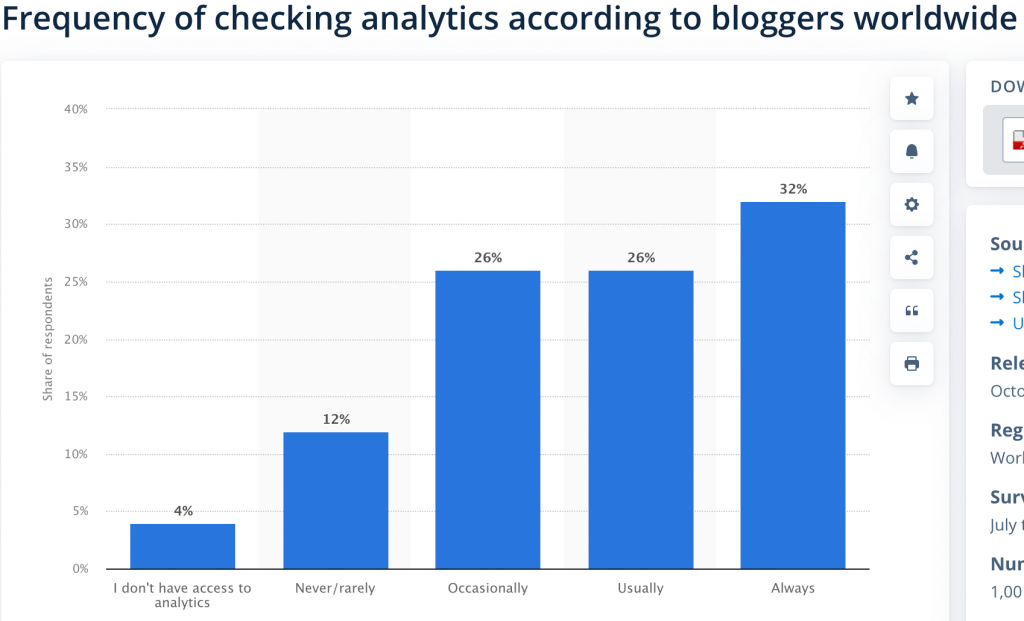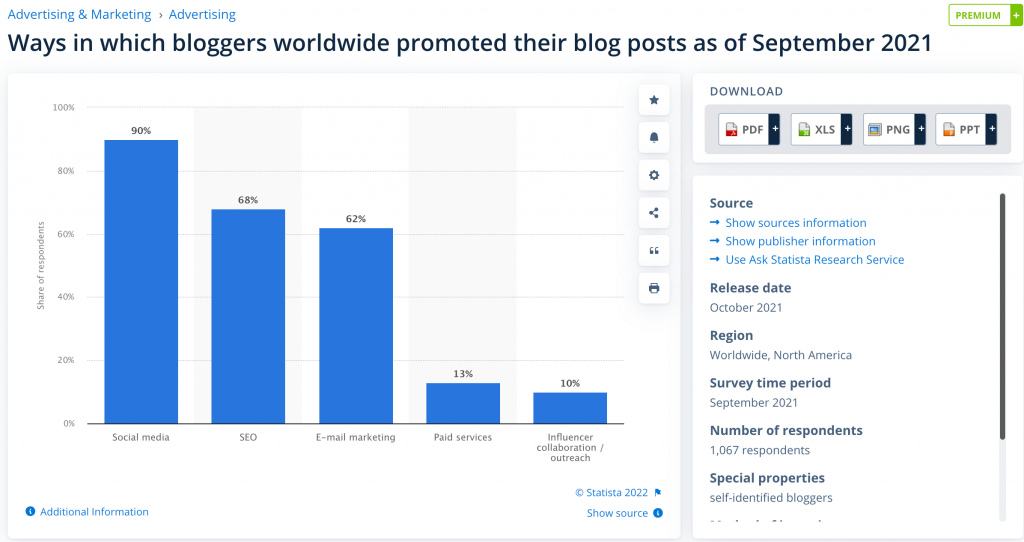Similar to social media marketing, content marketing is one of today’s most popular and effective advertising strategies.
As revealed by data, content marketing costs 62% less than traditional marketing approaches and drives three times the number of leads. On top of that, it also offers exceptional brand visibility potential.
Continuing with the statistics, did you know that 82% of content writers who blog see a good return on investment from their inbound marketing efforts?
Now that we’ve gotten a better idea of just how powerful content marketing can be for a company, let’s take a look at some blogging stats. We’ll examine future trends and best practices for marketers looking to dip their toe into blogging in 2024.
Blogging statistics demonstrating the amount of traffic generated by blogs
An SEO-optimized article, particularly one that covers a topic of significant interest, can be a gold mine for your site, bringing in massive amounts of traffic.
With organic search accounting for 51% of all website traffic, the need for SEO optimization is undeniable.
Sounds appealing, right? The question on everyone’s lips is; how much traffic can a company with a well-coordinated content marketing plan actually get?
Since data never lies, let’s take a look at what some blogging stats have concluded:
- The integration of a blog within a website can lead to traffic increases exceeding 434%;
- Companies with quality content on their blogs can see a traffic boost of about 2,000%;
- Businesses that publish 16+ monthly blog posts get more traffic than businesses with fewer blog posts;
- Articles with 1 or more lists drive 2X more traffic;
- Companies that have regular blog posts experience twice as much email traffic than companies that don’t;
- More than 50% of bloggers report that it has become harder to get traffic from Facebook over the past two years, while about one-fifth complain that it has gotten harder to get traffic from Google;
- Only 32% of bloggers regularly check their blog’s traffic analytics.

Blogging statistics proving blogging’s high ROI
Some blogs benefit from amazing traction by being integrated into a company’s website, especially if the company is a popular brand, however this isn’t always the case.
On the other hand, some are simply blogs created by writers sharing their feelings or knowledge on different domains to help other professionals. These can – at times – gain astounding popularity thanks to their genuineness.
Regardless of the blog’s niche, the key to success and generating great traffic lies in your content’s authenticity, creativity, and usefulness.
If you’re thinking about starting your own blog in 2024, here’s info brought to light by the latest blogging industry statistics that can get you started on the right path.
- Marketers who take blogging seriously are 13x more likely to have a positive ROI on their efforts;
- Huffington Post (the most profitable blog worldwide), earns an annual income of $500 million;
- 57% of marketers say they’ve gained customers specifically through blogging;
- B2B companies with blogs get 67% more leads than their counterparts that don’t have blogs;
- Companies that are consistent in their posting get 97% more links to their websites.
- SEO leads have a 14.6% close rate, while outbound leads (such as direct mail or print advertising) have a 1.7% close rate;
- Companies that blog actively get 126% better lead growth;
- Food and personal finance blogs make around $9K per month on average;
- A blogger’s average salary is $52K per year.
Informative blog posts are passed on
The internet is full of content, whether it’s long-form or short-form, video, written, or audio.
Knowing that they have a wealth of information available, users tend to give any given piece of content a very short window of time before moving on. This makes it paramount that your blog articles offer enough value to keep readers hooked!
How can that be done?
According to B2B blogging statistics from various sources, informative and emotional content is the top-performer of 2023. This applies not only to the context of SEO – but also in terms of generating shares and virality.
As the latest blogging statistics have revealed, blog posts with high emotional value have a 1000x greater chance of being shared.
Keep that in mind when creating your next blog post, and see how it performs compared to others that may lack this crucial component! Trust that you’ll find your successful blogging recipe by following what the numbers have to say!
Trends in blog post length
To rank on Google’s first page – or even better, in the number one position – an article has to meet a couple of criteria.
First and foremost, it must have a bulletproof SEO optimization (as in having the right keywords inserted) and provide value to the reader. Once this foundation is in place, you have to give it that sprinkle of magic to set it apart from the other content available and ensure that it outranks the current positions.
In most cases, this translates into extra information added. So – what is the optimum length for a successful blog article in 2024?
Here’s what the latest blogging statics have unveiled:
- The average blog post is 2,330 words;
- Seven-minute read blog posts are the best-performing;
- 55% of bloggers report that blog posts with a length of at least 2,000 words generate excellent results
- Blog articles between 3,000 – 10,000 words generate the highest amount of shares;
- Compared to shorter articles, longer blog articles get 77.2% more inbound links;
- Longer headlines are proven to increase CTR ( titles with more than 8 words can deliver an increased CTR of up to 21%);
- Titles with 6-13 words attract the highest and most consistent amount of traffic.
Trends in content promotion
Unfortunately for writers looking for quick results, blogging is a long-term objective initiative.
Depending on the quality of your content, you’ll start seeing results sooner or later. However, to receive a visibility boost, start interlinking your blog posts.
Moreover, for offering good exposure, social media is considered to be one of the most effective channels for article promotion, so it’s worth a try as well.
If you’re interested to learn more about content promotion, check out what these blogging statistics have reported.
- Over the past year, there’s been a 93% increase in blogs using promotional techniques to drive traffic to their post including paid ads;
- 90% of bloggers mention social media as a primary promotion medium for their blog posts, and 62% use email marketing to direct people to their content;
- More than 60% of marketers re-post the same content on social media, sharing it 2-3 times.

Trends in blogging frequency
- Around 50% of bloggers publish weekly or a couple of times per month;
- Guest-posting is a common practice for about 60% of content writers;
- 22% of bloggers tend to post 2 to 3 blog posts weekly;
- 60% of bloggers write 1-5 guest posts per month;
- 67% of bloggers that post daily report outstanding results;
- 38% of bloggers say that they update older blog posts;
- 50% of bloggers perform outreach for guest posts to 10 or fewer contacts a month;
- 60% of bloggers write one to five guest posts per month.
Trends in blog images
- Blog posts that integrate images get 94% more views than those without;
- Using visuals as part of a marketing strategy is common practice for 71% of bloggers;
- Most bloggers include two to three images per article on average;
- Integrating 10 or more images in an article can generate amazing results, according to 39% of bloggers.
- Switching stock photos with ones portraying real people can drive a 35% conversion increase.
Trends in editing
- The average timeframe needed to write a single blog article is around 4 hours.
- Before choosing the final version of a title, 58% of bloggers write 2-3 headline versions;
- Including a number in the headline increases the reading chance of the blog post for about 30% of readers.
- Article titles that contain colons or hyphens get a 9% higher CTR;
- 4% of bloggers work with editors, while 46% edit their own posts;
- 79% of editors say guest content is too promotional.
Trends in blogging formats
- Headlines written in the form of a “how-to” (similar to list-based articles) are the third most popular, being preferred by about 17% of readers;
- 36% of readers prefer listicle head titles;
- Audio content in blog posts (such as embedded podcasts) can improve an article’s performance by 45%;
- Video blogs have increased in popularity; YouTube records about 5 billion daily views;
- Video content is 50 times more likely to drive organic search traffic than plain text;
- Articles that include video content are more successful in retaining the consumers for longer – readers spend 88% more time on those pages;
- 43% of consumers report a need for more video content from marketers in blog posts;
- Only 19% of bloggers currently include video content in their regular articles.
- WordPress is the fastest growing blogging platform;
- 71% of blog posts on WordPress are written in English.

Key takeaways
The first and most important lesson that all these blogging statistics emphasize is how imperative it is for content writers to produce high-quality, well-researched blog content. The fact that the average time needed to write a successful blog post continues to rise year after year is the best indication of that.
Another important takeaway from the 55 blogging stats mentioned above is that if bloggers want to improve their SEO in 2024, they must update their previous blog posts.
To wrap up this list of business blogging statistics, for the time being, I’ll give one last piece of advice.
The key to making outstanding blog posts, according to many marketing professionals, is to aim for evergreen content! Keep this in mind as you create your next content calendar.


![My Honest Content at Scale Review in 2024: Is This the Best AI Writing Tool for Bloggers [Promo Code for 20% More Post Credits] Content at Scale review](https://inboundblogging.com/wp-content/uploads/2024/03/content-at-scale-review-150x150.jpg)
